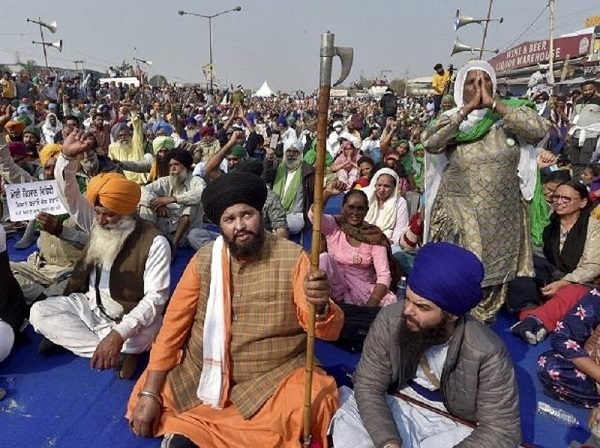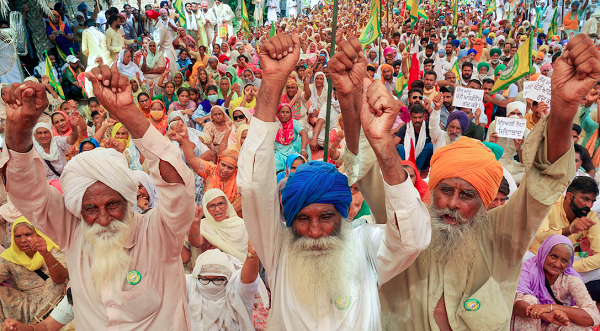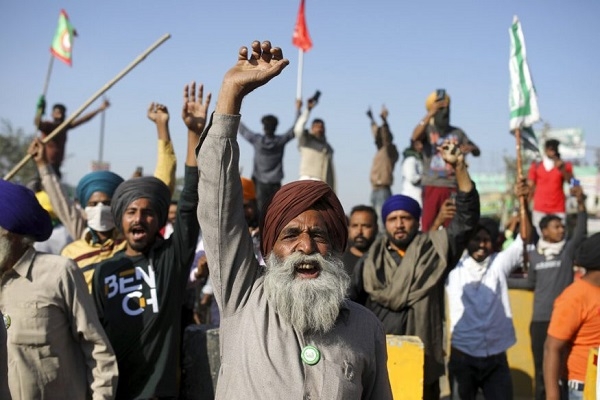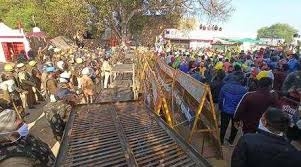Farmer’s Protests or Mela or Picnic?
Rajdeep Sardesai’s – India Today – video ground report of Ghazipur and Singhur on “Farmers Day” reveals the nature and character of the ongoing “Farmers Protests” on the outskirts of Delhi. De facto, “Protests” have turned into “Melas or Picnics” besides assuming political overtones. None can deny that protestors are unrelenting in their one point demand - “Repealing of the 3 Laws”.
Logistics of “Mela and Picnic” includes: air conditioned SUVs with reclining beds; Tractors with long trolleys converted like “Caravans” (unthinkable in Southern States) laden with ration and other items have been parked all through the 80-km stretch between Delhi and Rohtak; Bivocs or arctic type tents; large scale open air “Langars or Dhabas” serving round the clock hot teas/coffees, Kheer sweet dish, Rotis with Sarson Ka Saag, Lassi and Ladoos, Hookahs, Foot Massage and physiotherapy stalls/service, library, shaving and laundry services, Tatoo artists, gym facility, entertainment artists etc.

When interviewed by Sardesai, some of the protestors replied that they are receiving aid and funds from their NRI brothers and sisters. As per media reports, Khalsa Aid International, UK based organization, is utilizing its volunteer base to feed 15,000 people with hot meals on daily basis, distributing essential day packs, including toothbrushes, toothpaste, soap, sanitary towels, tarpaulin sheets, mosquito nets, medical kits and clothing to the protestors besides tankers full of milk and water.
A brief look at the array of protesting groups exposes the fraud of their claims of being apolitical as claimed by Bharatiya Kisan Union Ekta Ugraha (BKU Ekta Ugraha) led by ex-Army man Joginder Singh Ugrahan in 2002, which is active in the Malwa region – rich farmers’ belt - of Punjab. Less known is the fact that BKU (Ekta Ugraha) runs a parallel government in Punjab.
Next, in the forefront of the protests is Bharatiya Kisan Union (BKU) founded by Charan Singh that became Punjab branch. The western UP branch was founded on 17th October 1986 by Mahendra Singh Tikait, which is affiliated to the All India Kisan Sangharsh Coordination Committee.
Most important, list of 8 Punjab politically affiliated protesting farmers' unions include: Kul Hind Kisan Federation (MCPI); Jamhuri Kisan Sabha (Revolutionary Marxist Party); All India Kisan Sabha (CPI-M); Kirti Kisan Union (CPI-ML); Punjab Kisan Union (CPI-ML); Kul Hind Kisan Sabha (CPI); Bharatiya Kisan Manch (Akali Dal); and Bharatiya Kisan Union Lakhowal (Akali Dal).
List of 4 politically affiliated protesting farmers' unions of Haryana and Madhya Pradesh include: Bharatiya Kisan Union Tikait; Bharatiya Kisan Union Chaduni (AAP); Bharatiya Kisan Union Mann (Congress); and Rashtriya Kisan Mazdoor Mahasangh. Add to them, Yogendra Yadav of Swaraj Party.
List of Punjab’s non-politically affiliated protesting farmers' unions include: Krantikari Kisan Union; Bharatiya Kisan Sabha Dakaunda; Kisan Sangharsh Committee; Azad Kisan Sangharsh Committee; Jai Kisan Andolan; Kisan Mazdoor Sangharsh Committee; Kisan Sangharsh Committee; Bharatiya Kisan Union Krantikari; Bharatiya Kisan Union Sidhupur; Bharatiya Kisan Union Kadian; Bharatiya Kisan Union Rajewal; Bharatiya Kisan Union Doaba; Bharatiya Kisan Union Mansa; and others.
In sum, the present agitation is led by 35 farmers' unions - 31 among them are from Punjab alone, and the rest from UP, Haryana and Madhya Pradesh. Included among them are 10 political farmers' unions with political affiliations to include six farmers' unions from various Left organizations and two from the Akali Dal, besides five owing allegiance to the AAP, Swaraj Party and the Congress. And, all of them have come prepared for the “Long Haul” supported by funds pouring in from their “brothers and sisters” living in foreign countries, besides Khalsa Aid and its affiliations.
To recall, till 1978, the Punjab Khetibari Union (PKU), also known as Punjab Khetibari Zamindari Union, and Haryana's Kisan Sangharsh Samiti were the only two farmers' unions active in the entire North India. PKU was renamed Bharatiya Kisan Union (BKU) in 1978. BKU split in 1982 and was reorganized by well-known farmers' leader Mahendra Singh Tikait in October 1986. Later on, BKU split into several factions, and BKU (Ekta Ugraha) remains one of the largest.

Undeniably passions and emotions are running high among the protestors. Naturally, several political party-backed outfits are bound to exploit opportunities available to them to reclaim vote banks. They are bound to stall any breakthroughs in negotiations as they have their own ideologies, demands and methods of protest and also hell bent upon the break-up of the BJP led NDA. If so, the fallout is simple and contra implementation of long pending “Agriculture Reforms”.
De facto, there is obfuscation of key issues of agricultural sector? Agricultural output of India lags far behind its potential. The study of comparative data of average yields per hectare with productive farms clearly reflect “wide gaps”: Rice 3.3 tons compared to 10.8 tons in Australia; Cow milk 1.2 tons compared 10.3 tones in Israel; Wheat 2.8 tons compared 8.9 tones in Netherlands; Sugar cane 66 tons compared to 125 tons in Peru; Cotton 1.6 tons compared to 4.6 tons in Israel; Fresh Vegetables 13.4 tons compared to 76.8 tons in USA; Potatoes 19.9 tons compared to 44.3 tons in USA; Tomatoes 19.3 tons compared to 524.9 tons in Belgium; Eggs 0.1 tons compared to 0.42 tons in Japan; and so on.
Experts have mapped several factors for low productivity: large subsidies; 70% of holdings being less than one hectare in size; declining soil fertility, inadequate irrigation facilities with 39% total cultivable land irrigated as of 2010 with rest dependent on inconsistent monsoons; inadequate storage and distribution infrastructure resulting in nearly 30% losses; and overregulation of agriculture has increased costs, price risks and uncertainty.
Next, shrinking size of farms is yet another key issue: declined from 2.3 hectares in 1970-71 to 1.08 hectares in 2015-16; with the share of small and marginal farmers increasing from 70% in 1980-81 to 86% in 2015-16. In 2015-16, the average size of marginal holdings was only 0.38 hectares (less than one acre). The monthly income of small/marginal farmers was around ₹4,000 and ₹5,000 as compared to ₹41,000 for large farmers. Many small farmers cannot leave agriculture because of a lack of opportunities in the non-farm sector.
In the context of rural poverty, B. S. Minhas had argued even in the 1970s that compulsory consolidation of land holdings alongside land development activities could enhance the incomes/livelihoods of the poor in rural areas. Unfortunately, there is little discussion now on land fragmentation and consolidation of farm holdings.
Add to them, the fraud of crop loan waivers. Six critical issues to determine loans include: 1) categorization of farmers; 2) varieties of crops; 3) different Agro-climatic zones; 4) loan waivers; 5) MSP; and, 6) agriculture policies and transfer of advanced cultivation technologies.
The basic facts of loans: Crop Loan based on Pass Books @Rs.50, 000/- per acre; and Mortgage Loans based on 50% of market value of land. Obfuscation of categorization farmers is real. Categories of “farmers” include: small (2-acres), marginal (5-acres), medium (10-20 acres), large and Corporate farmers particularly of plantations, seed farms etc. Ironic but true, the generalization of “poor farmers” is the worst fraud. Today, the majority of farms owned by landlords are cultivated by tenant farmers on 50:50 shares. Viewed in the overall context, small farmers with 2-acres land must be beneficiaries of ‘loan waivers’. Left out are “tenant farmers” – real workhorses – denied “loans”. Tenant farmers are not eligible for loans from Agricultural Cooperative Banks and Commercial Banks. They take loans from money lenders at 18 to 30% interest rates.
Next, varieties of crops include: Cereals like Rice, Wheat, Maize, Oats, Millets, sorghum, Ragi, etc; pulses/Dals like Moong, Lentils, Peas, Cowpea, Chickpea, Soya, etc; vegetables (both perishables and non-perishables; cotton; variety of fruits; Tobacco, Nuts (Almonds, Cashew, Ground, Walnut, Pista etc); mustard, zinger, Coffee, Tea, Rubber and Coconut Plantations, Opium, heroin, flowers etc.
Furthermore, the country climatically can be categorized in different agro-climatic zones. Punjab, Haryana and Western UP, which enjoy the privilege of canal-fed irrigation facility, cannot be equated with the rain-fed and 2-crop canal-fed irrigation facility of the Deccan Plateau. Even the issue of “Farmers loan waivers” of those under the “Canal Irrigation” systems facilitating assured 2 to 3 crops in a year needs pragmatic review.

How can bank loans and Rythu Bandhuallocations be availed by a fairly good number of “City Dwellers” owning farm lands acquired alongside the National and State Highways as “Real Estate” investments and lying barren or cultivated by tenant farmers? Is it the most heinous fraud?
In retrospect, the issue of ‘farm loan waivers’ requires a de novo review after considering categorization of farmers, varieties of crops and climate conditions. Today, all categories of farmers avail loans. Today, if one takes a survey of loans by farmers in Telangana region, majority take loans from banks even after being beneficiaries of Rs.10,000/- per year for 2 crops under Rythu Bandhu Scheme.
Be that as it may, politics over economics of farm loans reflects intellectual bankruptcy. As per Niti Ayog, farm loan waivers are not a long term solution. A cursory look at the loan waivers by various states include: Rs.70, 000 crore by BJP ruled UP, Maharashtra; Rs.60,000 crore by Congress Party ruled MP, Chhattisgarh and Rajasthan. No concern for fiscal discipline and revenue deficit. For example, revenue surplus states like Telangana have become revenue deficit states.
Punjab Chief Minister Captain Amarinder Singh had declared that his government would take over the debt of every farmer, totaling Rs 67,000 crore. However, the Punjab government has so far waived only Rs 1,750 crore of loans up to an amount of Rs 2 lakh each availed by marginal farmers from cooperative banks. The state is only now about to launch a second round of waiver covering loans worth Rs 1,771 crore from commercial banks, which is again restricted only to marginal farmers.
The justification by ‘farmers lobbies” for “farm loan waivers” is simple. When the government is giving so many concessions and waiving off multinational companies taxes and debts, what is wrong in waiving off agricultural loans.
Finally, dynamic changes in the rural social milieu that is All India phenomenon. No more, youth are prepared to work in the fields. All they want are government jobs with laid back working environs and flood gates of corruption opportunities available to them. With job opportunities limited in the growth of private industry in the aftermath of Khalistan movement going back to 1979 and thereafter, youth look forward to migrate to foreign countries. Those left behind take to politics and illegal ways of amassing wealth. In particular, unemployment of white collar jobs is a grim reality particularly in Punjab.
Most important, the five common demands raised by the protesting farmers' unions include: Repeal the three new farm laws; guaranteed MSP (written assurance in the form of a Bill) and retention of conventional food grain procurement system by the Centre through Mandi’s; scrap the Electricity (Amendment) Bill so that the farmers do not lose free electricity provisions; scrap the Stubble Burning provision, and the release of farmers arrested on charges of burning paddy stubble in Punjab.
However, there is also the 13-point charter by some farmers' unions like the BKU (Ekta Ugraha) and Left-affiliated farmers' unions. The additional ones include: Implement Universal Public Distribution System (PDS) throughout the country to include all essential food and non-food items of basic necessities; fix profitable MSPs for all crops; roll back steps directed towards deregulating and decontrolling trade and commerce of farm produce in favor of big Indian and foreign traders and multinational companies; put an end to farmers' exploitation in government-regulated agriculture produce markets; and make inputs available to farmers at subsidized rates; immediately release detained and imprisoned intellectuals, democratic rights activists and student activists all over the country and withdraw false cases registered against them; withdraw all restrictions imposed against the right to struggle; and primarily provide relief of interest given to farmers; and so on.

Let me highlight that “Agriculture” is a State subject. So, free electricity and farmer’s loan waiver is the responsibility of the State governments. And, the State Governments indulge in blame games.
And, the Central Government is responsible for overall fiscal management, fixing of Minimum Support Price (MSP), agriculture infrastructure and exports of agriculture products. What is urgently needed is a holistic review of “Agricultural” policies. The National Commission on Farmers, chaired by Prof. M. S. Swaminathan, submitted five reports through the period December 2004 - October 2006. His final report focused on causes of famer distress and the rise in farmer suicides. He recommended addressing them through a holistic national policy for farmers. He had highlighted the need for land reforms, irrigation, credit and insurance, food security, employment, productivity of agriculture and farmer competitiveness.
Ipso facto, lost opportunities in the farm sector extending over the past 3 decades is real. Hardly political leaders applied themselves to formulate credible policies and ensure their effective delivery at the grass root levels particularly to enhance productivity or yields of various crops.
Justified is the demand for revision of MSP due to increase in input costs particularly labor costs - Rs. 300 per head of women labor in current context. However, even the labor costs too vary from region to region. The Government has announced MSPs for 22 mandated crops and fair and remunerative price (FRP) for sugarcane. The mandated crops are 14 crops of the kharif season, 6 Rabi crops and two other commercial crops. In addition, the MSPs of toria and de-husked coconut are fixed on the basis of the MSPs of rapeseed/mustard and copra, respectively. In the Union Budget for 2018-19, the MSP for cereals and pulses to guarantee farmers at least 50 per cent returns on production costs has been announced in accordance with the Swaminathan Report.
As on date, Indian agricultural practices following the “Green Revolution” are still stuck at what can be termed as “Generation 2 Technology”. In contrast, advanced countries are practicing “Gen 3 or 4 Cultivation Technologies”. So, there is a need for a paradigm shift to “Gen 3 Cultivation Technologies”: Doubling Productivity with less water and high-breed seeds under controlled conditions like Green Houses. Even in situ “Value addition” and marketing practices must adopt streamlined processes.
What is needed is an entirely different and dynamic agricultural reforms and modernization including "Green House Technology" in large acreages as done in Almeria 'greenhouses in Spain – 26000 hectares in one place.
Next, facilitating direct farmer-consumer linkage remains only on paper. The conventional 4-stage marketing continues: Auction Platforms to Marketing Centers/Brokers-Retailers-Consumer chain. Centralized post-harvest management and value addition remains a mirage. And, the middle-man or brokers exploit the farmers to the hilt – buy at Rs.2 per Kg and sell it to the customers at Rs.20 per kg.
Other suggestions of M S Swaminathan Commission remain on the backburner like availability of data about spot and future prices of commodities through the Multi Commodity Exchange (MCD) and the NCDEX and the APMC electronic networks covering 93 commodities through 6000 terminals and 430 towns and cities besides, State APMC Acts relating to marketing, storage and processing of agriculture produce to shift to one that promotes grading, branding, packaging and development of domestic and international markets for local produce, and move towards a Single Indian Market.
What is worrisome are the enlarging liabilities of States to their gross state domestic product (GSDP) — above 25% with Punjab at a high of 33% and MP exceeding 25%. The Government must order either a Parliamentary Committee or an Experts Commission to undertake a de novo holistic review on “farm loan waiver” based on criteria and conditions specific to each region and category of farmers.
The only silver lining is the setting up of Agri-Market Infrastructure Fund, with a corpus of Rs 2,000 crores, for developing and upgrading agricultural marketing infrastructure in the 22,000 Gramin Agricultural Markets and 585 Agricultural Produce Market Committees. This will enable farmers in remote locations to connect to markets. ‘‘Operation Green’’ on the lines of ‘‘Operation Flood’’ to tackle the volatility of tomato, onion and potato prices is an imperative.
Furthermore, on August 9, 2020, Modi launched the Rs 1 lakh crore Agriculture Infrastructure Fund (AIF) to be used over the next four years. This fund will be used to build post-harvest storage and processing facilities, largely anchored at the Farmer Producer Organisations (FPOs), but can also be availed by individual entrepreneurs. The fund will also be used to provide loans, at concessional rates, to FPOs and other entrepreneurs through primary agriculture credit societies (PACs).
Nonetheless, no early breakthroughs can be expected through talks. Vested political interests and strongly entrenched traders want to persist with the age-old “Commission agents – Atreya’s” in the grain mandis particularly in Punjab for they get a commission of 2.5% of total sales from the buyer that is among the highest in the country. They also extend informal credit to the farmers at very high interest rates. Given that the new farm laws are bound to reduce their profits, it is no wonder that they are in the forefront of protests with their air conditioned SUVs.
The best option for the Modi led BJP/NDA government is to enact an Ordinance that includes all assurances given in a letter form to the farmers union. It must be followed by tabling the amendments in the forthcoming Budget Parliament session to be held from January 31, 2020, to February 11, 2020.
What is urgently needed is a holistic review of “Agricultural Reforms and Policies.” Long overdue is the “Second Green-Cum White Revolutions”. Instead the farmers protests – mostly Northwestern States centric – want to hijack “Agriculture Reforms” meant for the benefit of farmers.



